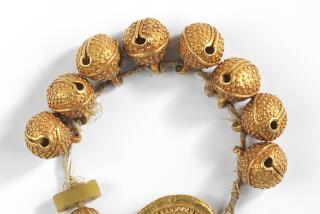Quest for Hidden Riches Becomes Man’s Obsession
BIRCH TREE, Mo. — Gerald Taylor is talking, but the words are lost in the crunch of leaves beneath his shoes as he fights through the heavy brush of the Mark Twain National Forest.
One of the sticker bushes finally gets him, slashing an inch-long gash on his right hand. He walks on, unbothered by the oozing blood, continuing to mouth words that can’t be heard.
Suddenly, silence. Taylor steps into a clearing on a steep slope, kicks away a few fallen branches, and smiles.
“Here it is,” he said.
Perhaps six feet below the ground is an abandoned silver mine, a mine where South American Jesuits in colonial times hid tons of silver bars, jewels, coins and other treasures.
At least that’s what Taylor believes.
“I’m 101% sure,” he said. He estimates the bounty’s value to be at least $200 million, perhaps 10 times that.
The U.S. Forest Service believes the only thing under the ground is more dirt and rocks. That’s why since 1988, they’ve repeatedly refused his request to dig for treasures there.
“It would be nice to think somebody could find buried treasures, but there’s nothing in the record to support him,” said Jody Eberly, a wildlife biologist for the forest service.
Taylor, 45, hasn’t held a job since the early 1980s. His single-minded pursuit is to get to a treasure that experts agree doesn’t exist.
“I’ve got my life devoted to this thing. This is the one that everybody dreams of,” said Taylor, a retired auto worker who collects payments for a disability he wouldn’t reveal.
There are plenty of dreamers around the country. Treasure hunting has become a multimillion-dollar hobby. Magazines, newsletters, clubs and countless equipment dealers are devoted to people seeking buried treasure, sunken ships filled with riches, or gold in them thar hills.
Marci Stumpf, managing editor of Gold and Treasure Hunter magazine, estimated that 350,000 people around the United States hunt for hidden treasure in one form or another.
Most might run a metal detector over the beach, or spend a day on vacation panning for gold. Only a handful of people devote their lives to it.
“Most are in it for the thrill of discovery,” said Brenda Nelson, coordinator for the Modern Gold Miner & Treasure Hunter’s Assn., based in Happy Camp, Calif. “They just do it because it’s relaxing, fun, and you might find a nugget.”
Taylor knows exactly what he’s looking for.
In the early part of the century, Taylor’s great-grandfather farmed the land where the alleged mine sits, in far south-central Missouri. Family legend was that a silver mine was buried somewhere on the property, but no one knew where.
The land was eventually sold to the forest service and turned into part of the vast national forest. Still, Taylor kept going back, looking for clues.
About a decade ago, he found them--two rocks, one with the markings of a cross, the other with what looks like a turtle.
Taylor believes the rocks are markers pointing to the silver mine. His hypothesis is that a third marker, yet unfound, completes a triangle that helped lead the Jesuits, perhaps from Bolivia, to the place where they buried vast treasures inside a productive silver mine in the late 1700s.
“That’s just absolute beyond-belief balderdash,” said Charles Polzer, a Jesuit priest and historian who is a curator at the Arizona State Museum. “There were no Jesuits in the south of Missouri whatsoever.”
There also were no known silver mines there. Besides, Jesuits were not allowed to be involved in mining, Polzer said. “We didn’t go out and hide things. That’s one of the legends.”
Polzer said anti-Catholic sentiment in colonial times spurred rumors that the Jesuits were mining treasures and stashing them away.
In fact, Spanish-speaking Jesuits never even made it to southern Missouri until decades later, said Light T. Cummins, a Texas history professor who has written two books on Spanish colonial history of the Mississippi Valley.
“Spain did not acquire domination of that area known as Spanish Louisiana until 1764. In 1766, the entire Jesuit order was expelled from the New World by Spain. The Jesuits had no presence at all in that area,” Cummins said.
Taylor is undaunted by the historical record.
“Are you thinking they’re going to put a big bulletin board above the road that they’ve got this silver here?” he asked.
Taylor has spent thousands of dollars gathering evidence aimed at persuading the forest service to allow him to dig. He hired two archeologists to examine the area. Both found traces of silver in the dirt at the site, Taylor said. Neither archeologist returned phone calls from the Associated Press.
Taylor also hired a pilot with infrared equipment to do a flyover. Pictures from the flyover indicate the presence of buried silver, he said. Taylor also used an electronic scanning device that he said proved silver was below the surface.
“The arrow went off the meter,” he said.
Taylor believes forest service workers damaged artifacts while searching for the treasures themselves. He said at least 20 forest service employees are involved in a cover-up, which is why they won’t let him dig.
“They tried to steal it, destroyed an artifact, and they’re using their positions to stay out of prison,” Taylor said.
The forest service denies that. Spokeswoman Charlotte Wiggins noted that Taylor was permitted to dig at a nearby site in 1988. Nothing was found. Taylor said further research indicated he was at the wrong place in the 1988 dig.
Taylor said his quest is aimed at more than treasure hunting. He believes the artifacts in the mine would be of historical significance.
“This thing could be resolved in 30 minutes with a backhoe,” Taylor said. “If I’m lying, I leave the forest with a red face. But if I’m right, America sees some really neat artifacts that have been hidden from them.”
More to Read
Sign up for Essential California
The most important California stories and recommendations in your inbox every morning.
You may occasionally receive promotional content from the Los Angeles Times.










